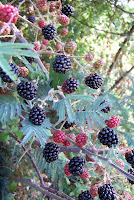Sorry it's been a while since the last post, but the weather has been so good, we've been working hard. It's been dry since the last post, quite cold at times, but spring-like whenever the sun makes an appearance. We've dug over more beds in preparation for spring and continued pruning the olives at Popetto. The last few trees are turning into real hard work, but we're slowly getting there.
There are a couple of things I want to talk about today. Firstly I read this article in the Guardian about this guy who has given up cash for a year, and no I don't mean he is paying everything by credit card! Here's the link:
http://www.guardian.co.uk/environment/green-living-blog/2009/oct/28/live-without-money. Now we're not a million miles away from what he is doing, rarely being in posession of any cash. Unfortunately we still have to pay for electricity and phone bills and can't quite do without a car.
Well this man set up a "freeconomy community", which I've just joined: http://www.justfortheloveofit.org/. On this people list their skills and equipment to offer for free to other community members. Unfortunately there's no one near me yet who has also joined, so all of you, whether you live near me or not, join! This is such a great idea.
Today I am starting an at least monthly series on wild foods of the season. Our short cold spell is over and herbs are growing everywhere again, sending us on forages. Of course each region will have different plants or they will be ready at different times of the year, but I'll give you a glimpse at what we collect and what you can do with it. There's not a month without some wild crop or other which can be harvested.
So here we go, wild food for January: the humble daisy

In fact it can be gathered any time of the year when the ground isn't covered by snow. Both the flowers and the ground hugging leaves are edible. Simply throw them into a salad to add a mild camomile flavour. The leaves can be boiled briefly together with other greens or stirred into a risotto or soup. They are said to have a cleansing, detox effect.
The other plant we have started gathering is
common chicory.

http://en.wikipedia.org/wiki/Chicory. That photo is actually a cheat, as it is flowering radicchio, which is a close relation to the wild chicory. The leaves of wild chicory are a bit similar to dandelion (another relation and of course also edible), but less indented. As with dandelion the younger the leaves the less bitter they are. In fact at the moment the tender young leaves are more sweet than bitter. This is explained by the fact that they contain a high concentration of inulin, which is a good sugar substitute for diabetics.
All plants of the chicory family are hostile to intestinal parasites, so drive out any worms you may have. How to eat them? Well of course you can add them to your salad as well to give a bit of a bitter/sweet edge to it, but the most popular way it is used here in Italy by just blanching them in boiling water for 1/2 minute or so, drain and serve with a dressing of lemon juice and olive oil as side veg.
 A large part of the manure went to make a base in my newly constructed cold frame, topped up with some all purpose shop bought compost. The manure hasn't completely broken down and the final fermentation should create a bit of heat and turn the cold frame into more of a hot frame (well it's a bit draughty, so maybe a warm frame...).
A large part of the manure went to make a base in my newly constructed cold frame, topped up with some all purpose shop bought compost. The manure hasn't completely broken down and the final fermentation should create a bit of heat and turn the cold frame into more of a hot frame (well it's a bit draughty, so maybe a warm frame...).






 Blackberries together with cloves and cinnamon bark is steeped in alcohol, than cut down to about 43%AbV. It turns out the colour of a well known 1970's Beat combo and the spicyness went really well with my spicy Christmas biscuits.
Blackberries together with cloves and cinnamon bark is steeped in alcohol, than cut down to about 43%AbV. It turns out the colour of a well known 1970's Beat combo and the spicyness went really well with my spicy Christmas biscuits. I know they are elderflowers on the picture, but I didn't have a photo of elderberries handy. Anyway, the berries get steeped in grappa for 40 days. The resulting brew is only lightly sweetened. Another great flu preventative. Had we not had this, I'm sure we would have come down with swine flu!
I know they are elderflowers on the picture, but I didn't have a photo of elderberries handy. Anyway, the berries get steeped in grappa for 40 days. The resulting brew is only lightly sweetened. Another great flu preventative. Had we not had this, I'm sure we would have come down with swine flu!